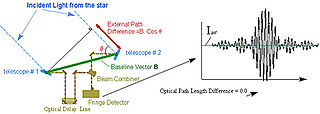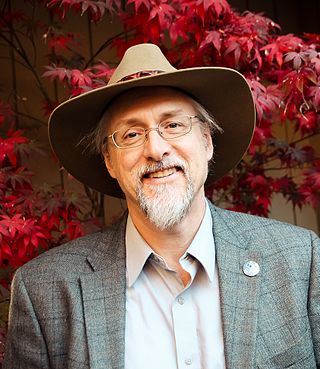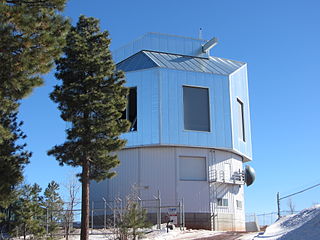
Astrometry is a branch of astronomy that involves precise measurements of the positions and movements of stars and other celestial bodies. It provides the kinematics and physical origin of the Solar System and this galaxy, the Milky Way.

Clyde William Tombaugh was an American astronomer. He discovered Pluto in 1930, the first object to be discovered in what would later be identified as the Kuiper belt. At the time of discovery, Pluto was considered the ninth planet, but was reclassified as a dwarf planet in 2006. Tombaugh also discovered many asteroids, and called for the serious scientific research of unidentified flying objects.

The Kitt Peak National Observatory (KPNO) is a United States astronomical observatory located on Kitt Peak of the Quinlan Mountains in the Arizona-Sonoran Desert on the Tohono Oʼodham Nation, 88 kilometers (55 mi) west-southwest of Tucson, Arizona. With more than twenty optical and two radio telescopes, it is one of the largest gatherings of astronomical instruments in the Earth's northern hemisphere.

Percival Lowell was an American businessman, author, mathematician, and astronomer who fueled speculation that there were canals on Mars, and furthered theories of a ninth planet within the Solar System. He founded the Lowell Observatory in Flagstaff, Arizona, and formed the beginning of the effort that led to the discovery of Pluto 14 years after his death.

The United States Naval Observatory (USNO) is a scientific and military facility that produces geopositioning, navigation and timekeeping data for the United States Navy and the United States Department of Defense. Established in 1830 as the Depot of Charts and Instruments, it is one of the oldest scientific agencies in the United States, and remains the country's leading facility for astronomical and timing data.

Lowell Observatory is an astronomical observatory in Flagstaff, Arizona, United States. Lowell Observatory was established in 1894, placing it among the oldest observatories in the United States, and was designated a National Historic Landmark in 1965. In 2011, the Observatory was named one of "The World's 100 Most Important Places" by Time Magazine. It was at the Lowell Observatory that the dwarf planet Pluto was discovered in 1930 by Clyde Tombaugh.

Hoag's Object is an unusual ring galaxy in the constellation of Serpens Caput. It is named after Arthur Hoag, who discovered it in 1950 and identified it as either a planetary nebula or a peculiar galaxy. The galaxy has a D25 isophotal diameter of 45.41 kiloparsecs (148,000 light-years).

Eleanor Margaret Burbidge, FRS (née Peachey; 12 August 1919 – 5 April 2020) was a British-American observational astronomer and astrophysicist. In the 1950s, she was one of the founders of stellar nucleosynthesis and was first author of the influential B2FH paper. During the 1960s and 1970s she worked on galaxy rotation curves and quasars, discovering the most distant astronomical object then known. In the 1980s and 1990s she helped develop and utilise the Faint Object Spectrograph on the Hubble Space Telescope. Burbidge was also well known for her work opposing discrimination against women in astronomy.

The National Optical Astronomy Observatory (NOAO) was the United States national observatory for ground-based nighttime ultraviolet-optical-infrared (OUVIR) astronomy. The National Science Foundation (NSF) funded NOAO to provide forefront astronomical research facilities for US astronomers. Professional astronomers from any country in the world could apply to use the telescopes operated by NOAO under the NSF's "open skies" policy.

Lowell Observatory Near-Earth-Object Search (LONEOS) was a project designed to discover asteroids and comets that orbit near the Earth. The project, funded by NASA, was directed by astronomer Ted Bowell of Lowell Observatory in Flagstaff, Arizona. The LONEOS project began in 1993 and ran until the end of February 2008.

Robert Burnham Jr. was an American astronomer, best known for writing the classic three-volume Burnham's Celestial Handbook. He discovered numerous asteroids, including the Mars crossing asteroid 3397 Leyla, and six comets.

Marc William Buie is an American astronomer and prolific discoverer of minor planets who works at the Southwest Research Institute in Boulder, Colorado in the Space Science Department. Formerly he worked at the Lowell Observatory in Flagstaff, Arizona, and was the Sentinel Space Telescope Mission Scientist for the B612 Foundation, which is dedicated to protecting Earth from asteroid impact events.

The Navy Precision Optical Interferometer (NPOI) is an American astronomical interferometer, with the world's largest baselines, operated by the Naval Observatory Flagstaff Station (NOFS) in collaboration with the Naval Research Laboratory (NRL) and Lowell Observatory. The NPOI primarily produces space imagery and astrometry, the latter a major component required for the safe position and navigation of all manner of vehicles for the DoD. The facility is located at Lowell's Anderson Mesa Station on Anderson Mesa about 25 kilometers (16 mi) southeast of Flagstaff, Arizona (US). Until November 2011, the facility was known as the Navy Prototype Optical Interferometer (NPOI). Subsequently, the instrument was temporarily renamed the Navy Optical Interferometer, and now permanently, the Kenneth J. Johnston Navy Precision Optical Interferometer (NPOI) – reflecting both the operational maturity of the facility, and paying tribute to its principal driver and retired founder, Kenneth J. Johnston.
Arne Henden is a retired American observational astronomer, instrument and software specialist, and co-discoverer of a minor planet. He formerly served as director of the American Association of Variable Star Observers (AAVSO). The asteroid 33529 Henden is named after him.
Anderson Mesa Station is an astronomical observatory established in 1959 as a dark-sky observing site for Lowell Observatory. It is located at Anderson Mesa in Coconino County, Arizona, about 12 miles (19 km) southeast of Lowell's main campus on Mars Hill in Flagstaff, Arizona.

The Lowell Discovery Telescope (LDT), formerly the Discovery Channel Telescope (DCT), is a 4.3 m (170 in) aperture telescope owned and operated by Lowell Observatory. The LDT was built at a dark sky site in the Coconino National Forest near Happy Jack, Arizona. Happy Jack is located at an elevation of 2,360 m (7,740 ft) and is approximately 65 km (40 mi) south-south-east of Flagstaff. The project was initially a partnership between Discovery Communications and Lowell Observatory. The research partnerships have been extended to include Boston University, The University of Maryland, The University of Toledo, Northern Arizona University, and Yale University. The telescope cost $53 million. It significantly augments Lowell Observatory's observational capability and enables pioneering studies in a number of important research areas.
The United States Naval Observatory Flagstaff Station (NOFS), is an astronomical observatory near Flagstaff, Arizona, US. It is the national dark-sky observing facility under the United States Naval Observatory (USNO). NOFS and USNO combine as the Celestial Reference Frame manager for the U.S. Secretary of Defense.

David John Eicher is an American editor, writer, and popularizer of astronomy and space. He has been editor-in-chief of Astronomy magazine since 2002. He is author, coauthor, or editor of 23 books on science and American history and is known for having founded a magazine on astronomical observing, Deep Sky Monthly, when he was a 15-year-old high school student.
3225 Hoag, provisional designation 1982 QQ, is a dynamical Hungaria asteroid from the innermost regions of the asteroid belt, approximately 5.5 kilometers in diameter. It was discovered on 20 August 1982, by American astronomer couple Carolyn and Eugene Shoemaker at the Palomar Observatory in California. The stony S/L-type asteroid has a short rotation period of 2.37 hours. It was named for American astronomer Arthur Hoag.

Noah Brosch is an Israeli astronomer, astrophysicist and space researcher.

















